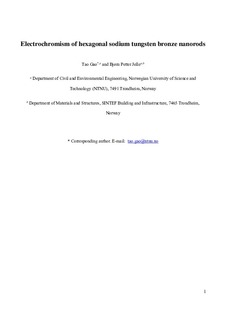| dc.contributor.author | Gao, Tao | |
| dc.contributor.author | Jelle, Bjørn Petter | |
| dc.date.accessioned | 2018-02-22T06:51:24Z | |
| dc.date.available | 2018-02-22T06:51:24Z | |
| dc.date.created | 2017-11-15T01:03:22Z | |
| dc.date.issued | 2018 | |
| dc.identifier.citation | Solar Energy Materials and Solar Cells. 2018, 177 3-8. | nb_NO |
| dc.identifier.issn | 0927-0248 | |
| dc.identifier.uri | http://hdl.handle.net/11250/2486273 | |
| dc.description.abstract | Single-crystalline sodium tungsten bronze (Na-WO3) nanorods with typical diameters of 10–200 nm and lengths of several microns have been prepared via a simple hydrothermal method. The as-prepared Na-WO3 nanorods crystallize in a hexagonal structure and elongate along the <001> crystallographic direction. The as-prepared Na-WO3 nanorods have eight diagnostic Fourier transform infrared (FTIR) absorptions at 3604, 3545, 1622, 1600, 983, 790, 480 and 430 cm−1, which represent specific fingerprints of the vibrational features of hexagonally tunnel-structured Na-WO3 containing tunnel water molecules. The as-prepared Na-WO3 nanorods exhibit a typical cathodic electrochromism, which is related to a proton-electron double insertion process. X-ray diffraction results indicate a phase transformation of hexagonal Na-WO3 nanorods during the electrochromic process, of which the involved local structural evolutions such as water decomposition and proton insertion have been discussed by using FTIR spectroscopy. The results suggest that, during the electrochromic coloration process, the inserted protons might occupy the small trigonal tunnel positions instead of the large hexagonal ones. | nb_NO |
| dc.language.iso | eng | nb_NO |
| dc.publisher | Elsevier | nb_NO |
| dc.rights | Attribution-NonCommercial-NoDerivatives 4.0 Internasjonal | * |
| dc.rights.uri | http://creativecommons.org/licenses/by-nc-nd/4.0/deed.no | * |
| dc.title | Electrochromism of Hexagonal Sodium Tungsten Bronze Nanorods | nb_NO |
| dc.type | Journal article | nb_NO |
| dc.type | Peer reviewed | nb_NO |
| dc.description.version | acceptedVersion | nb_NO |
| dc.source.pagenumber | 3-8 | nb_NO |
| dc.source.volume | 177 | nb_NO |
| dc.source.journal | Solar Energy Materials and Solar Cells | nb_NO |
| dc.identifier.doi | 10.1016/j.solmat.2017.11.025 | |
| dc.identifier.cristin | 1514212 | |
| dc.relation.project | Norges forskningsråd: 193830 | nb_NO |
| dc.description.localcode | © 2017. This is the authors’ accepted and refereed manuscript to the article. Locked until 8.12.2019 due to copyright restrictions. This manuscript version is made available under the CC-BY-NC-ND 4.0 license http://creativecommons.org/licenses/by-nc-nd/4.0/ | nb_NO |
| cristin.unitcode | 194,64,91,0 | |
| cristin.unitname | Institutt for bygg- og miljøteknikk | |
| cristin.ispublished | true | |
| cristin.fulltext | original | |
| cristin.fulltext | postprint | |
| cristin.qualitycode | 2 | |

